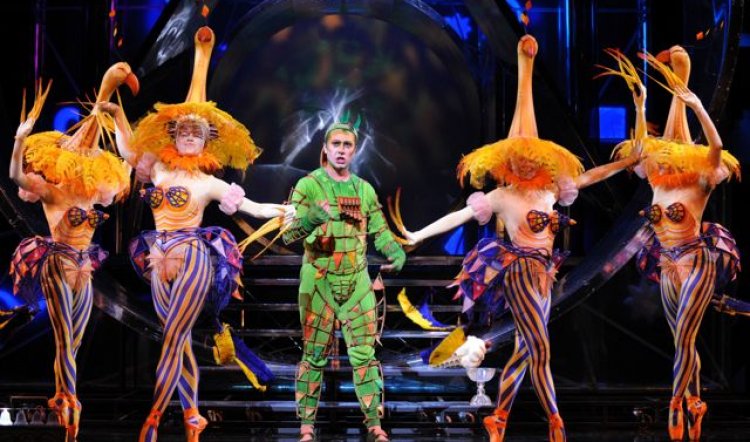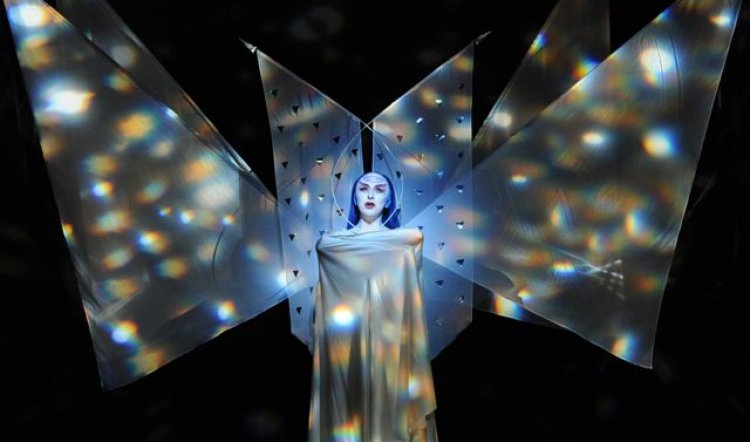
THE MAGIC FLUTE
THE MAGIC FLUTE, Sydney Opera House, Opera Australia by arrangement with the Metropolitan Opera; 6 January-23 March 2012. Photos by Branco Gaica,
In Christopher Lawrence's program essay for this fabulous production of The Magic Flute he writes a true thing – of opera in general, Mozart in particular and even more specifically, of this production – and it is the observation that "…Mozart's message would appear to be that the magic of music lies not in how it is made, but in how we choose to receive it."
The word "choose" is the key: do we choose to be as open and imaginative as Mozart himself (and his collaborator here, the American theatre maven Julie Taymor)? Or do we go along with the lemon-suckers who demand that an opera be staged "traditionally"? And if it's the latter, what do they mean? In the manner of its first production, 220 years ago? In the way it was done 20, 50 or 100 years ago? In all cases Mozart would be spinning in his grave as sticking to the original script or score was not something he ever did or ever intended.
And that's the problem with "historical accuracy" and "faithful versions" – whether it's restoring an old house or remounting an old opera – it's not actually about either as both states are more about myth and legend and personal foibles than correctness (whatever that is). So…
As it happens, Julie Taymor is – arguably – the ideal director-visionary to tackle The Magic Flute. Everything about her experience and visual aesthetic leads to a confluence of magic and logic. This production is at once logical and whimsical, magical and succinct; rarely can this (frankly barking mad) story and its bizarre characters have been so well served. Originally produced in 2004 for New York's Metropolitan Opera, Taymor's inventiveness is – in this cut-down form: two hours including interval – both aural and visual, and memorable.
Sung in unusually natural English in a new(ish – 2000) translation by eminent yet witty librettist and poet, JD McClatchy, the work is well served by a young and exuberant cast that has to handle not only Mozart's musical fireworks, but also come to terms with Taymor's extravagant costumes, masks and make up and a typically dazzling array of puppetry (dancing bears, stilt-walking birds, a huge serpent, stately flying swans and so on). And then there are her demands on the chorus: amazing costumes, much movement and precious few hiding places. For the audience the spectacle is tremendous, but not at the expense of music and performance and the Mozartian heart of the opera.
In an interview with Michael Clive for the US website Classical TV, Taymor said of her ideas for the Flute, "We use the term fairy tale interchangeably with myth, yet fairy tale is for children and myth for adults. The fantasy elements in Magic Flute are something you find in the lore of every culture, in stories of coming of age and of heroes. You find the same themes in all cultures, in African folk tales and in Greek mythology — the journey from youth to adult, the adventure, the ordeal that transforms, that deepens character. These are the trials that Pamina and Tamino are put through in abstract form, all the struggle of breaking away from the parent, the teenage child who has to break away. The child-like aspect, the aspects that are funny and charming, the humour of Papageno and Papagena — these are no different than the devices you find throughout Shakespeare or in commedia dell’arte."
She was also typically thoughtful in commenting in the same interview on the always complained of sexism and short-end-of-the-straw treatment of Pamina and the Queen of the Night. "We present the female parts as originally as they were originally conceived; yes, the men are sexist, I don’t have a problem with that. That’s the sect of Sarastro — it’s sexist, and the Queen of the Night’s bitterness is understandable. You can understand why she is outraged; her daughter was stolen from her. Of course she would say 'I’m going to use everything in my power to get her back.' It’s not all that surprising that in this kind of literature, which comes to us from men, symbols are used in this way: The moon and the Queen are associated with witchcraft and darkness, with the vastness of nature, with the irrational — basically, with things men couldn’t understand. The male symbols are of light, the sun, Sarastro’s realm…the light-filled image of the pyramid in the desert. This association of women with the irrational and men with the rational — this is an age-old prejudice, and it is innate to the story. It doesn’t hurt the story because Pamina is strong and independent, and has her own way."

And finally, Taymor stakes what is – to me – an irrefutable claim for her interpretation of the piece: "What’s interesting about The Magic Flute is that it’s really a musical, isn’t it? There’s an enormous amount of spoken dialogue interrupted by these songs that express the characters’ deepest thoughts and emotions. That’s how a musical works. But that doesn’t mean that the arias should be static; there’s plenty of opportunity for movement. Look at Papageno; with his two songs there is action going on, he’s dreaming of his perfect bird partner. He moves in the arias, they are completely physicalized. The composer and the librettist tell me what to do. I don’t foist ideas upon the music and lyrics, I’m directed by what’s in the score. Just listen and imagine — if you can imagine, then you can see what to do. Opera is a perfect union, a perfect art form, it’s to be listened to and watched. It’s wonderful to direct an opera that can be interpreted in so many different ways and so visually."
And that she has, with original design by George Tsypin, lighting design by Gary Marder, based on the original by Donald Holder and choreography by Matthew Barclay based on the original by Mark Dendy. The orchestra, under conductor Jonathan Darlington, sparkled yet was judicious in volume and pace – providing an aural comfort zone for the principal voices of Andrew Jones in whom Taymor couldn't have found a more endearingly cheeky and energetic Papageno (although he does need to slow down on his pan-pipe runs and not so carelessly throw away his ruling motif); Andrew Brunsdon – a handsome, plausible and sweet-voiced prince Tamino – and David Parkin, who looks and sounds marvellous but as yet can't quite get the bassest of bass notes demanded of the high priest Sarastro.
As the Queen of the Night, Emma Pearson began her daunting first half task with a slightly tight throat but, by the time she arrived at the second act's most famously awe-inspiring solo "Hell's vengeance boils in my heart", she was in marvellous form. As her hapless daughter and Tamino's love, Nicole Car made Pamina a charming and strong presence, as did Kiandra Howarth, coming in thanklessly late in the action as Papageno's gorgeous girl-in-disguise, Papagena.
As Sarastro's sleazy underling with a name like an contagious disease (Monostatos), Kanen Breen inhabits his extraordinary make up and fat suit with disturbing ease, stealing scenes left, right and centre. In narrative terms, he provides an interesting balance to the all-round Boy's Own chappishness of Papageno and Tamino and is just terrific.
The fabled trio of the First, Second and Third Ladies is beautifully sung and performed – with extra-dimensional mask-head dresses – by Jane Parkin, Sian Pendry and Tania Ferris; while the First, Second and Third Spirits (William McDermott, Matthew Phillips and Jussi Jenssen) are possibly the best harmonising boy sopranos ever to don long white beards and ghostly robes and white-face.
It's often said that The Magic Flute is the ideal opera for children or opera virgins: debatable when it drags on for three hours and more of seemingly interminable yammer; but this production actually is the real deal: funny, clearly told, musically excellent, exciting and magical to see and experience. Tickets for kids start at $53 and there are family packages too. If you and your family loved Taymor's landmark staging of The Lion King and if you saw and were enthralled by her movies, especially Frida and The Tempest, you'll find all her trademark visual creativity, dramatic wit and innovation at the Sydney Opera House in this beautiful and captivating version of The Magic Flute.



